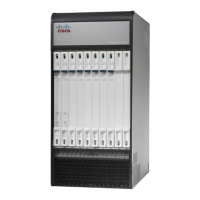Mode Commands, LTE Policy Configuration Mode Commands and Congestion Action Profile
Configuration Mode Commands in the Command Line Interface Reference for more information.
•
Repeat this configuration as needed for additional thresholds.
Configuring Service Congestion Policies
To create a congestion control policy, apply the following example configuration in the Global Configuration
mode of the CLI:
configure
congestion-control policy service action { drop | none | redirect | reject }
end
Notes:
•
When the redirect action occurs for PDSN services, the PDSN responds to the PCF with a reply code
of 136, "unknown PDSN address" along with the IP address of an alternate PDSN.
•
redirect is not available for PDIF. The default action for PDIF is "none."
•
When the redirect action occurs for HA services, the system responds to the FA with a reply code of
136, "unknown home agent address".
•
redirect cannot be used in conjunction with GGSN services.
•
redirect is not available for the Local Mobility Anchor (LMA) service.
•
When setting the action to reject, the reply code is 130, "insufficient resources".
•
For the GGSN, the reply code is 199, "no resources available".
•
For the SaMOG, MME, redirect is not available.
•
For the MME, create action profiles for optional major and minor thresholds using the
congestion-action-profile command under lte-policy in the Global Configuration mode.
•
For the MME, you can specify service as critical, major or minor to set a policy and associate an
action-profile for the respective threshold. See Global Configuration Mode Commands in the Command
Line Interface Reference for more information.
Configuring Overload Reporting on the MME
When an overload condition is detected on an MME and the report-overload keyword is enabled in the
congestion-control policy command, the system reports the condition to a specified percentage of eNodeBs
and proceeds to take the configured action on incoming sessions. To create a congestion control policy with
overload reporting, apply the following example configuration:
configure
congestion-control policy mme-service action report-overload reject-new-sessions enodeb-percentage
percentage
end
Notes:
•
Other overload actions include permit-emergency-sessions and reject-non-emergency-sessions.
ASR 5500 System Administration Guide, StarOS Release 21.5
203
Congestion Control
Configuring Service Congestion Policies

